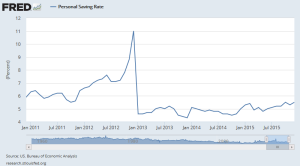News Story of the Day: If there is one thing that Americans are horrible at it’s saving money. The national savings rate is around five percent, and this shows in a new statistic: most Americans are unable to cover a $500 emergency.
According to a Bankrate.com national survey, 63 percent of respondents said they didn’t have enough money to cover a $500 car repair. Around 40 percent of Americans reported that they could rely on their savings to cover something that goes beyond their regular bills. Meanwhile, 23 percent said they could handle an emergency by slashing spending, while another 15 percent would borrow money from family and another 15 percent would use a credit card.
What does this mean? Most people are living paycheck to paycheck.
“The findings show that most Americans are financially vulnerable. Although consumer confidence numbers show Americans feeling good about jobs after the Great Recession, most still aren’t stashing money away,” the report says.
Chart of the Day: Speaking of savings, a chart from the St. Louis Federal Reserve highlights a terrible trend. From the height of the economic collapse until around the end of 2012, Americans were gradually lifting their savings rates to as high as 11 percent. Since then, however, that number has gone down dramatically. Here is the chart:
Illustration of the Day: You want to know how Bernie Sanders will solve the $18 trillion debt problem if he becomes president of the United States? Spend another $18 trillion.
Quote of the Day: Robert Wenzel has been doing a great job on espousing Austrian Business Cycle Theory over at Economic Policy Journal. Here is something he wrote Thursday:
The Federal Reserve is the central bank of the United States and its money manipulations do cause the roller-coaster economy and the business cycle, but there is much more to the economy than just the business cycle.
Further, business cycle theory is a theory about a cycle in the economy, specifically a boom and a bust. But note well: It is about both a boom and a bust. There is nothing in Austrian school business cycle theory that suggests a central bank can’t reverse a bust because “it has run out of bullets.”
ABCT is about the distortions caused by central bank money manipulations directing goods toward the capital goods sector and away from consumption goods. The bust occurs when the economy attempts to readjust funds directed to the capital goods sector back into the consumption sector. Unemployment caused during this readjustment period is the only unemployment that is explained by ABCT.
Video of the Day: John Oliver on the absurdity of the growing trend of voter ID laws. He also points out the hypocrisy that certain lawmakers showcase. Here is the video:


Leave a Comment